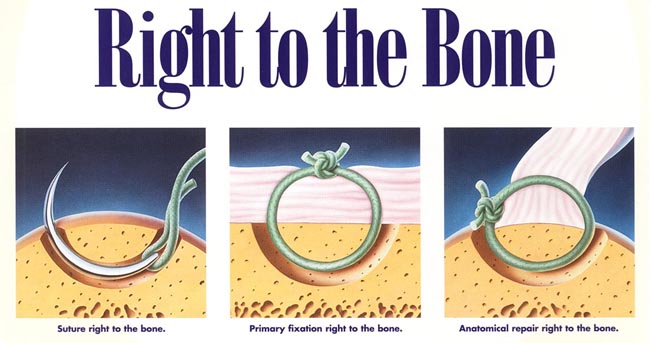The special thing about Dr. Kirby's technique is that
he stitches the capsular ligaments right to the bone. In '93 he tells me about
a new drill he is using which makes curved holes. In '00 Dr. Kriby is still
very excited about the drill, so much so that he gives me some of the marketing
literature for it. Among other things, I learn that in '93 I was only the 3rd
person on whom he used the drill, though he didn't tell me that then. He has
since done hundreds of operations with it. Before the curved drill there was
no easy way to perform this operation. Suturing to the bone was the best. But
the bone was very deep and providing enough exposure to operate a straight drill
was difficult. Other surgeons used other forms of attachments such as metal
hooks, but those could be problematic. As beneficial as the drill is, the inventor
has had a difficult time successfully marketing it and it is not yet in wide
use.
|
|
|
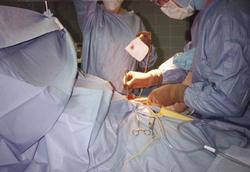 |
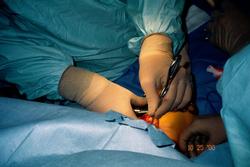 Initial
work to expose the damaged joint capsule Initial
work to expose the damaged joint capsule |
| |
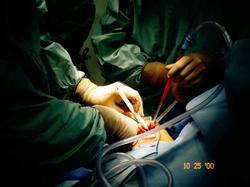 I think the device
with the wire is used to cauterize bleeding blood vessels. I think the device
with the wire is used to cauterize bleeding blood vessels. |
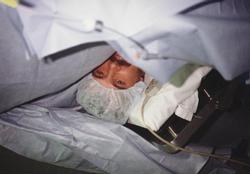 Me
under the sheets. They are right in my face and I have to keep my head turned
to the right. Me
under the sheets. They are right in my face and I have to keep my head turned
to the right. |
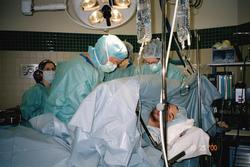 This
time the left me more space under the sheets and Kim would occasionally
push them out of my way. This
time the left me more space under the sheets and Kim would occasionally
push them out of my way. |
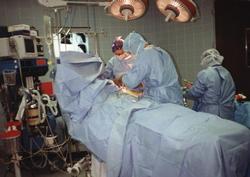 |
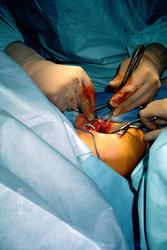 When I saw this
photo I thought: "Ouch! No wonder my shoulder hurts." When I saw this
photo I thought: "Ouch! No wonder my shoulder hurts." |
| At some point during this surgery they discovered
that necessary instruments had not been sterilized. This causes a delay
of ten or twenty minutes. |
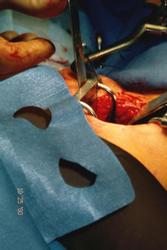 I felt a lot
of jostling, more than I was aware of in the first operation. I felt a lot
of jostling, more than I was aware of in the first operation. |
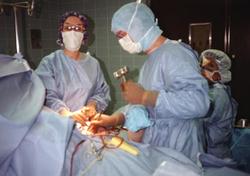 At one point Dr.
Kirby warned me that they were going to hammer on my bone. I told them to
get some pictures of this so they hammed it up a little. At one point Dr.
Kirby warned me that they were going to hammer on my bone. I told them to
get some pictures of this so they hammed it up a little. |
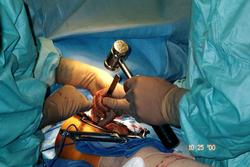 The hammering
roughs up the surface of the bone to which the ligament will be attached.
As they both heal they grow together. The hammering
roughs up the surface of the bone to which the ligament will be attached.
As they both heal they grow together. |
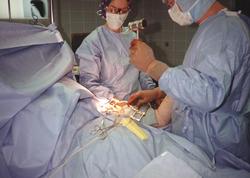 |
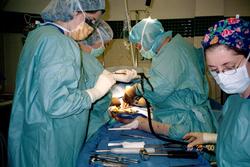 |
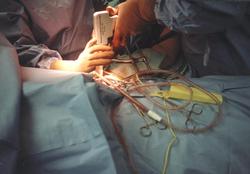 |
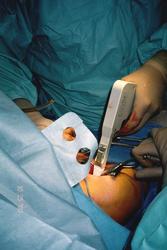 Drilling
the holes. Drilling
the holes. |
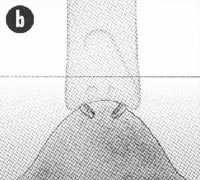 This
diagram shows how the drill cuts a curved hole. This
diagram shows how the drill cuts a curved hole. |
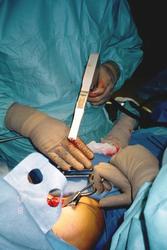 If you look closely
you can see the cutter heads of the drill. If you look closely
you can see the cutter heads of the drill. |
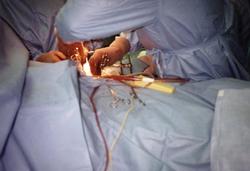 |
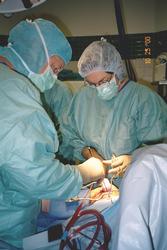 Now they must
be sewing the joint capsule to the bone. Now they must
be sewing the joint capsule to the bone. |
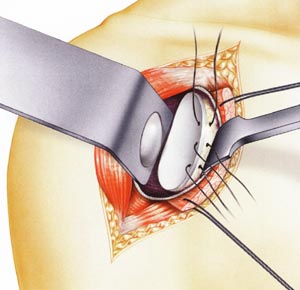 Another
diagram of the incision and where the sutures are placed. Another
diagram of the incision and where the sutures are placed. |
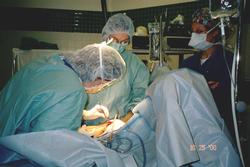 |
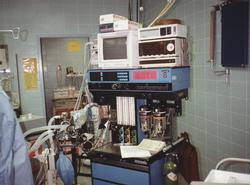 This large machine
was called the "narkomed". I thought that was a great name. This large machine
was called the "narkomed". I thought that was a great name. |
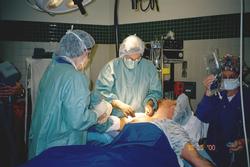 Here they are
dressing the incision. I'm looking over my shoulder to see if this OR also
has a narkomed. It doesn't Here they are
dressing the incision. I'm looking over my shoulder to see if this OR also
has a narkomed. It doesn't |
| |
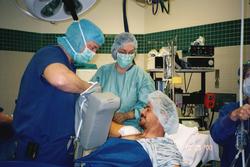 |
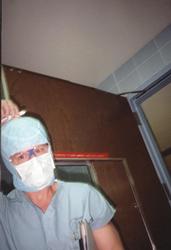 As
they wheeled me out of the OR I snap this picture of Dr. Kirby. They took
me to the recovery room. The folks there took one look at me and said I
was doing well enough to go directly up to my room. I'm wheeled back out,
up to another floor, then shifted into a bed As
they wheeled me out of the OR I snap this picture of Dr. Kirby. They took
me to the recovery room. The folks there took one look at me and said I
was doing well enough to go directly up to my room. I'm wheeled back out,
up to another floor, then shifted into a bed |
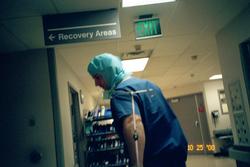 They shift me
from the table to a gurney and wheel me down the hall. I snap this picture
of Dr. Kirby leading the way to the Recovery area. They shift me
from the table to a gurney and wheel me down the hall. I snap this picture
of Dr. Kirby leading the way to the Recovery area.
I'm left in the gurney while they take my vitals. |
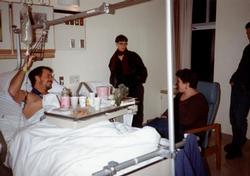 That
evening some friends come to visit me in my hospital room. I'm feeling pretty
good. That
evening some friends come to visit me in my hospital room. I'm feeling pretty
good. |
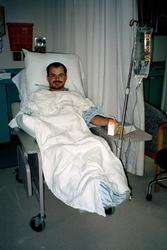 Everything looks
fine, so they have me get up and move to a chair where I wait for Marie. Everything looks
fine, so they have me get up and move to a chair where I wait for Marie. |
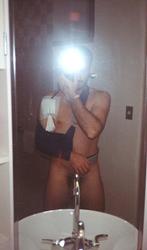 As
I was leaving the OR the anesthesiologist said something about how I won't
appreciate the nerve block until it wears off. It wears off sometime during
the night and my shoulder hurts. The nurse hooks me up to a Demerol drip.
It is a machine that will in inject Demerol into my IV when I push a button.
But it is calibrated to allow only a limited amount each hour. I get three
shots an hour and I pace them at 20 minute intervals. By the time 20 minutes
is up I'm ready for my next fix. As
I was leaving the OR the anesthesiologist said something about how I won't
appreciate the nerve block until it wears off. It wears off sometime during
the night and my shoulder hurts. The nurse hooks me up to a Demerol drip.
It is a machine that will in inject Demerol into my IV when I push a button.
But it is calibrated to allow only a limited amount each hour. I get three
shots an hour and I pace them at 20 minute intervals. By the time 20 minutes
is up I'm ready for my next fix.
Some time in the early morning they remove the IV. Latter I stagger into
the bathroom to pee, and snap this shot in the mirror. |
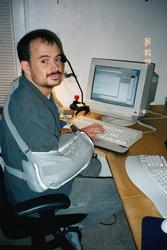 By
that evening I'm back home and feeling pretty good (the nerve block hasn't
worn off). I check my e-mail and laboriously write one or two messages with
my left hand. Marie and I watch a movie and soon I'm falling asleep. Marie
makes a nest for me in the spare bedroom where I can sleep in a sitting
position and I have a very restful night. By
that evening I'm back home and feeling pretty good (the nerve block hasn't
worn off). I check my e-mail and laboriously write one or two messages with
my left hand. Marie and I watch a movie and soon I'm falling asleep. Marie
makes a nest for me in the spare bedroom where I can sleep in a sitting
position and I have a very restful night. |
| My recovery takes a while. Laying on my back
causes my shoulder to ache so for weeks I must sleep sitting up. Even after
a couple weeks typing at the computer for very long will cause my shoulder
to ache. |
By noon on the next day the nerve block is wearing
off and my shoulder aches. It is not terrible pain, but enough that walking
around help take my mind off it. Shelly calls and suggests that I can take
the Perkaset a little more frequently than prescribe for a short time. I
do that the second night and sleep well again.
By Friday morning my shoulder is less achy and I'm taking the perkaset less
often than prescribed then begin to alternate with Tylenol. But by that
evening I'm feeling the constipating effects of narcotics. I'm only on the
narcotics for three days, but it takes my system over a week to recover.
My right shoulder recovers faster than my left. Laying down causes it to
ache, but with in a couple days I can easily type with out any pain. Every
week it is noticeably better than the previous week. |
I have often been asked how long the recovery takes. This is a difficult question
to answer as the process is gradual so it is hard to fix a time at which recovery
is complete. Here's what my experience was:
